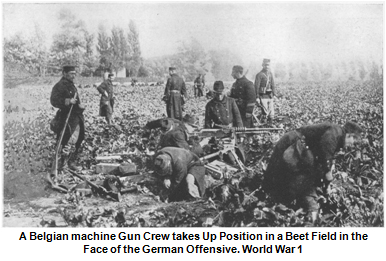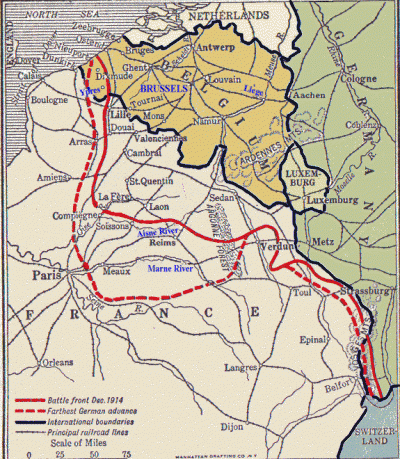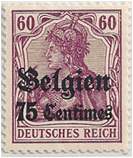ALBUM – view my German Occupation of Belgium – WW1 Album
Fast Facts
Region: Western Europe
Group: Occupations in Western Europe – ww1
Classification: Military Occupation
Prior Regime: Belgium
Key Dates:
1914, Aug 4 – Germans Invade Belgium
1914, Sept 6-12 – Battle of the Marne
1917, Nov – Flanders secedes from Belgium
1918, Nov 11 – Armistice signed, Germany withdraws from Belgium
Following Regime: Belgium
Scott Catalogue: (Belgium, Issued under German Occupation) #N1-N25
Pick Catalogue: (Belgium) #86-91
History
 Following the outbreak of World War I in 1914, the German Army opened the Western Front by first invading Luxembourg and Belgium, then gaining military control of important industrial regions in France. Since Belgium and Luxemborg and virtually no standing army, the advance was swift and decisive. The tide of the advance was dramatically halted at the Battle of the Marne. Both sides dug in along a meandering line of fortified trenches, stretching from the North Sea to the Swiss frontier with France. This line remained essentially unchanged for most of the war.
Following the outbreak of World War I in 1914, the German Army opened the Western Front by first invading Luxembourg and Belgium, then gaining military control of important industrial regions in France. Since Belgium and Luxemborg and virtually no standing army, the advance was swift and decisive. The tide of the advance was dramatically halted at the Battle of the Marne. Both sides dug in along a meandering line of fortified trenches, stretching from the North Sea to the Swiss frontier with France. This line remained essentially unchanged for most of the war.
Although the German advance was halted, they had overrun most of Belgium, which remained in German control for most of the War. German authorities governed harshly, confiscating food and property for troops, killing civilians who resisted, and forcing populous to work for the German war effort. These repressive measures were used effectively by the British to sway public opinion in the US, and help persuade the Americans to enter the war.
 Flanders, controlled by a radical minority who supported the Germans who supported an independant Flemish state, seceded from Belgium in November 1917. This was in spite that a great majority of the Flemish remained loyal to King Albert and Belgium.
Flanders, controlled by a radical minority who supported the Germans who supported an independant Flemish state, seceded from Belgium in November 1917. This was in spite that a great majority of the Flemish remained loyal to King Albert and Belgium.
In 1918, after a failed German offensive, Allied armies supported by the growing American Expeditionary Force broke through the German front lines, liberating large areas of Belgium. This defeat, forced the Germans to agree to an armistice, signed on 11 Nov, 1918. The Germans withdrew from Belgium, the Flemish government collapsed, and King Albert returned as the Belgian Government was restored.
Stamps
 ALBUM
ALBUM
The Germans issued stamps for use in occupied Belgium on 1 October, 1914. They were overprinted German Stamps of 1906-1918. Two sets of surcharges/overprints were issued. The first set spelled out the full denomination “Centimes” and “Franc” for the smaller denominations. The second surcharge/overprint abbreviated the denomination “Cent.” and “F.”. These stamps continued to be in use throughout the war and were used concurrently with the stamps of the German Western Military Command from 1916. As a note, the Belgian Government moved to Le Havre, France on 13 October, 1914 and continued to print stamps for use in unoccupied Belgium.
Banknotes
The Société Génerale de Belgique issued paper money in the German occupied areas between 1915 and 1918 in denominations of 1, 2, 5, 20, 100 and 1000 francs.
Links
The Western Front
German Occupations of the Belgium at the Belgian Philately site
German Occupation of Belgium at Stamp Collecting World





What is your price list on these country stamps. Preferably, WWW1 German Occupation. 1914-1918 I might be interested.
Hi Bruce. Thanks for visiting the site.
As I am a collector not a dealer, my stamps are not for sale. Sorry. One of these days I will organize my duplicates and non dead country stamps and sell them, but that is another day.
Cheers
Michael
Do you have any idea why a 10 centimes postal card of the WWI German occupation of Belgium, written in Stavelot and stamped with an “Ortskommandatur Stavelot” cachet (free of the indicium) was cancelled in Malmedy, then part of Germany, some 8 kilometers away ? Message is fairly routine, something about stamps but also general “I am fine” message, written in German. Card is sent to Braunschweig, would have cost 5 pfennig if sent from Malmedy. I found this item recently and wonder if there was some cross-border arrangement or if it might have been just a fluke. Thanks for your thoughts and comments.
Hi Frank
Thank you for visiting DC Stamps.
You didn’t delineate the date of the cancel, but I would guess since it was 10c that it was later in the occupation (late 1916 at the earliest). It is my understanding is that the use of these stamps were fairly broad behind the German Front, and “international” borders at the front were rather unsupported during this time. It could be entirely possible that the postal card was bought at a Post Office in Stavelot, and eventually posted in a few kilometers away in Malmedy, as the individual was travelling, (these stamps were primarily used for civilian mail).
If you want to stimulate a good discussion, you could post an image of it on Stampboards.com, in the 1914-1918 German Occupation overprint stamps from Europe thread. If you are not a member, joining is easy, but make sure that you post an introduction of yourself first in the introduction thread (see the rules for joining), as they are rather particular about this. There are many people who are quite knowledgeable in the area.
Good Luck and thanks again for your note.
Michael
Postcard was postmarked in Malmedy (German) 17 November 1914 and was Occupation of Belgium postcard #P2 in Michel catalog “Ganzsachen Deutschland 2011/2012.” 10 centimes would have been the correct franking from Belgium for a postcard to a foreign country, Germany. I suspect it got into the German mail stream through a fluke, nothing more, but an interesting item to have found.
Hi Frank, it is indeed an interesting find. I have been working on write ups on the German occupation of Alsace and Lorraine during WW2. In my research, I read that occupation stamps with the overprint Alsace (Elsaß), Lorraine (Lothringen) and Luxembourg, could be used across the occupied German area of France, as well as in Germany proper. This stopped, of course when the Germans attempted to annex the region in 1942. I wonder if there was a similar situation during WW1?
Michael
Well written and informative. Would like more detail; values and # issued plus areas served.
Hi Gary
Thank you for visiting DCStamps, I am glad that you find the site useful and informative.
First of all, I don’t usually give much on the value of stamps, as it is so variable based on so many factors, such as quality, condition, etc. Also, I try and keep the information on stamps brief in the description, but usually include more if you go to my album pages. As I am learning more about variations described in the Michel catalogue, I am actually working through my Belgian occupation stamps, and hopefully will show some of the different variations (and postmarks that I have). Stay tuned.
Also, I notice that my links are no longer available so I will update them with new ones, but one you can go to find far more detail is at the Belgian Philately page in the German Occupations section found at: http://www.belgiumstamps.org.uk/German%20Occupations.htm
Michael